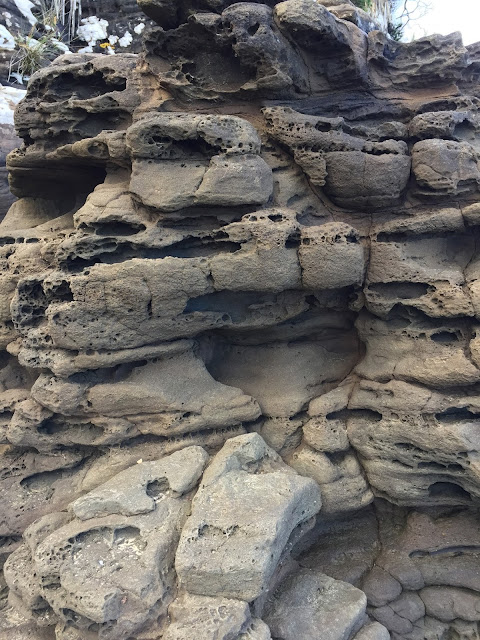It's both challenging and easy to take in The Catlins, assuming you have enough internal space to hold the glory of it all. The challenge? It's not compact. This is a wide-ranging region and you definitely need wheels to drive to all the beaches and waterfalls and through the exquisite countryside. We do have wheels, though, so let's start where we left off. Remember this arc of beach?
Well it turns out you can not only drive to it (walking from the lookout not an option), but you can drive right onto it!
The southern ocean tosses up some interesting characters
The backdrop is nearly as compelling as the ocean view. Art thought the white substance was some sort of lichen.
He went in close on some of the rock.
The circular depression holds water, possibly laden with rock dust.
Location of Tautuku Beach (
click here if reading in email to see map). This is one vast area of shoreline. If you look at the top photo again you can almost see all of it.
We took a little trip around it in the Rover, just because we could.
A bit more driving through this extravagantly beautiful region--why not? (I hope you know we dropped the caravan and aren't towing anything. When we are, it's pretty much straight to our destination.)
We traveled a short distance to the Tautuku Estuary, with its dreamy boardwalk. Every time we encounter a boardwalk I put on my best English accent and repeat what an older English woman said in Abel Tasman National Park when her group, given the choice between taking a wooded path or taking the boardwalk, said: Oh, but I do love a nice boardwalk!
So do I
A brief pause while I assure you we're still eating very well. Here's an award-winning sheep's milk haloumi with flecks of mint in it. Inspired.
The beauty of the Catlins leaves me breathless.

The next day we sought out Purakaunui Falls via a 15-km gravel road that pulled us higher with every turn.
Because it's the end of June and winter, every place we visit is deserted. High summer here is December (we still have occasional difficulty grasping what month it is). A little trek through a very dense green wood, the Purakaunui Falls Scenic Reserve, to our destination.
The innocuous stream to our left started to pick up a little steam along the way as it tumbled downward.
And suddenly the falls were in sight. We definitely heard them before we saw them. A hidden treasure.
60-foot drop over three main tiers. Not Niagara, but quite pleasing.
Catlins palate-cleanser
Next on our hope-to-do second day in Papatowai is to park at the estuary and walk the Old Coach Road to the beach.
Tahakope River mouth/estuary at low tide
The track follows the original route that horse-drawn coaches took after coming off the beach in Tahakopa Bay. After the track's start,
when it forks, go right. It's flat going, alongside the tidal river and a
very pleasant walk for all ages and abilities. In parts the original
coach road formation can be seen as it passes beneath a canopy of tree
fern, silver beech and young totara. Near the track's end, where there's
a host of regenerating totara is an important moa hunter archaeological
site.
The run of clear days here has been a gift.
Off the Old Coach Road, heading for the beach.
The lengthening shadows remind us of the almost imperceptible shift in light now after the Winter Solstice, a wee bit longer every day.
Today we drove eastward a bit to a campground in Pounawea. We're not done exploring yet...


























































